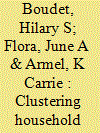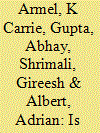|
|
|
Sort Order |
|
|
|
Items / Page
|
|
|
|
|
|
|
| Srl | Item |
| 1 |
ID:
150457


|
|
|
|
|
| Summary/Abstract |
Research on household energy conservation often categorizes targeted behaviours by their behavioural attributes (e.g., savings, cost, frequency). The most common distinction in the literature divides behaviours as follows: (1) low-impact, low-cost, repetitive behaviours that result in a loss of comfort or curtailment behaviours and (2) high-impact, high-cost, infrequent behaviours that result in no loss of amenities or efficiency behaviours. However, such categorizations have often been ad hoc and two-dimensional (e.g., low-impact vs. high-impact, low-cost vs. high-cost). In contrast, we systematically assess a large range of household energy-saving behaviours (N=261) across nine attributes – energy savings, cost, frequency of performance, required skill level, observability, locus of decision, household function, home topography, and appliance topography. By clustering behaviours according to these attributes, we discern four clusters of energy-saving behaviours: family style, call an expert, household management and weekend project. We discuss the implications of these clusters for intervention design.
|
|
|
|
|
|
|
|
|
|
|
|
|
|
|
|
| 2 |
ID:
117239


|
|
|
|
|
| Publication |
2013.
|
| Summary/Abstract |
This paper aims to address two timely energy problems. First, significant low-cost energy reductions can be made in the residential and commercial sectors, but these savings have not been achievable to date. Second, billions of dollars are being spent to install smart meters, yet the energy saving and financial benefits of this infrastructure - without careful consideration of the human element - will not reach its full potential. We believe that we can address these problems by strategically marrying them, using disaggregation. Disaggregation refers to a set of statistical approaches for extracting end-use and/or appliance level data from an aggregate, or whole-building, energy signal. In this paper, we explain how appliance level data affords numerous benefits, and why using the algorithms in conjunction with smart meters is the most cost-effective and scalable solution for getting this data. We review disaggregation algorithms and their requirements, and evaluate the extent to which smart meters can meet those requirements. Research, technology, and policy recommendations are also outlined.
|
|
|
|
|
|
|
|
|
|
|
|
|
|
|
|
|
|
|
|
|